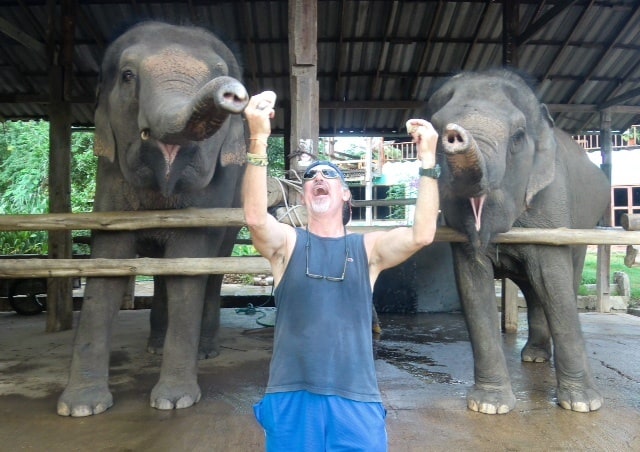Last Updated on October 28, 2024 by Ellen
We lived in Thailand for four months during calendar year 2019. It was a place I had long dreamed of and wanted to visit prior to my retirement and the start of our ‘endless global travel lifestyle’. After departing the country a few months ago, I find myself flashing-back to everything Thai: the people, the culture, the food, the religion, the amazing, the mundane, the beauty, the ugly (poverty, pollution, prostitution), the beaches and mountains and jungles and temples. But most of all, I think about the elephants.
This post is a travel commentary on the Thailand elephant situation — and our experience living with well-cared for elephants.
Thailand elephant debate (among Western visitors)
Our final stop in Thailand was in the northern town of Pai, about 50 miles from the border with Myanmar. There we stayed 18 nights – half of them at one of the “elephant camps” that dot the inland areas of the nation. The rest of the time we resided just a few minutes away, and went back to visit those same elephants every day.
It was such an interesting and unique experience that we recently made a proposal to the owner of the camp who we became very friendly with during our stay. We offered our daily time, labor, and assistance (mainly English translation and sales service) running the camp business for a future period of one month in return for room and board, so the owner could take an extended ‘dream vacation’ to the United States of America.
After consideration, our offer was declined. The trip to the U.S. wasn’t realistically possible at this time. Although we felt disappointed, we understand the huge responsibility of running an operation featuring Thailand elephant encounters and other tours, a hotel/restaurant, and a sales/marketing/maintenance staff was presently just too great to allow the owner to be absent for any lengthy period.
Still, I miss those elephants. Tutdao and Ot were the two ‘domesticated’, female, Asian elephants that we got familiar with during our stay at Thom’s Pai Elephant Camp – a highly ethical place where the owner and trainers treat the elephants like family. Tutdao and Ot were such amazing, smart, fun, and lovable creatures — and the hours of close interaction we had with them was like nothing I’ve ever experienced.
In all, I estimate I spent well over 50 hours during those weeks in very close proximity to Tutdao and Ot. I fed them, talked to them, walked, swam and washed them, chopped and collected their food, hugged and petted their trunks and faces, shoveled their manure, even put them ‘to bed’ in the jungle at night. Unforgettable!
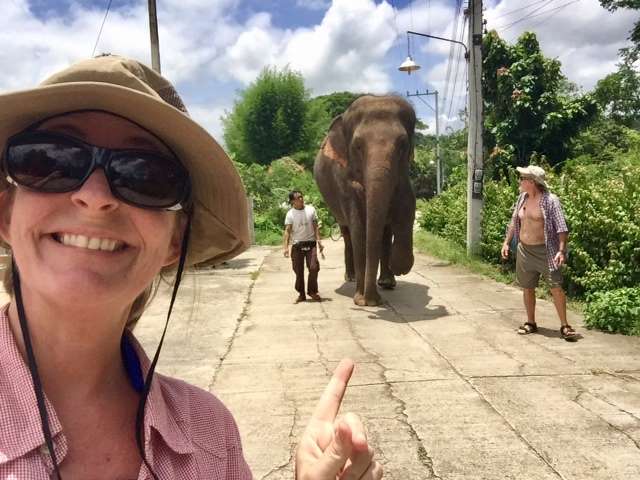
Horse owners likely know the kind of feeling I’m trying to describe: a mixture of awe and reverence and playfulness and pathos. These are majestic, 8,000 pound animals who could crush or decapitate a human any time they wanted – yet they seem content standing in their roadside stables taking food and photos with tourists and delighting paying customers with treks and swims and rides and tricks.
Of course, I’m well aware of the controversy regarding the exact situation I have just described. Many say that treating (and training) an elephant like a canine house pet is inhumane and wrong and businesses exploiting them should be boycotted. But, it is the current reality in Thailand.
We were told there were once an estimated 100,000 elephants “naturally” in the country. Now there are about 7,000 existing in Thailand elephant camps and sanctuaries and park preserves – and yes, in some people’s backyards. The animals have been an integral part of Thai culture and development for centuries. Their use in logging and construction and transport and commerce and warfare is no different than the age-old role of the horse or the ox in western society.
Elephants still ‘work’ with man in Thailand’s more rural and remote areas. But with modernization and urbanization and privatization of property throughout the nation, most of these incredible beasts are no longer seen as anything more than tourist attractions. It’s a sad statement to make; another unintended result of man’s unquenchable desire for progress and domination and money.
Sadly, there is no place for wild elephants. Sure, there are public and private sanctuaries in Thailand. Many of them provide a comfortable, natural, healthy existence for elephants. But be assured, even in these environments the animals are overseen, managed and subjected to human whims. Worse, some of the sanctuaries have simply been ‘rebranded’ for political correctness and the animals continue to face the very same issues that sanctuaries claim to address: inhumane treatment, poor nutrition and health, exploitation for profit.
At present, there is limited monitoring or certification of Thailand elephant welfare at either a governmental or private/industry/non-profit level. Efforts at establishing standards and compliance have been sporadic and voluntary for elephant owners. The situation is similar to the uneven patchwork of animal welfare laws and enforcement in the USA.
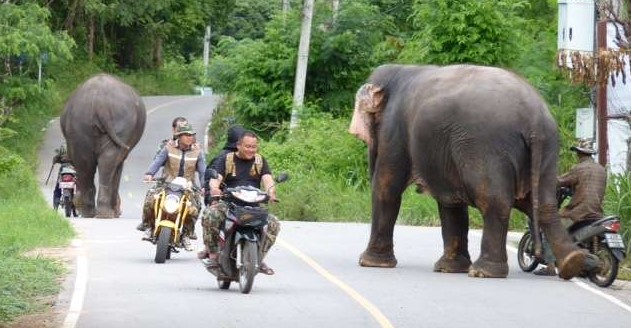
In the end, elephants like Tutdao and Ot remain scattered all over Thailand living in a variety of circumstances. We personally witnessed animals in obviously less comfortable situations at some of the other camps in Pai, tethered with very limited freedom of movement and standing in their own waste.
These conditions, and no doubt worse, are occurring right now and will continue. But boycotting seems counterproductive. Economically depriving the objectionable owners/operators is most likely to result in even more hardship to their animals. Elephants eat — a lot! Even in Thailand, food costs can be $30 or more per day per animal. Veterinary care is required and costly too. Wherever elephants are on the ‘wellness spectrum’, tourist spending and donations are what sustain the Thailand elephant population today.
There are no easy or immediate answers. It’s an unfortunate situation that is slow to change. During our visit, all we could do was live “in the moment” and form opinions based on our actual experience.
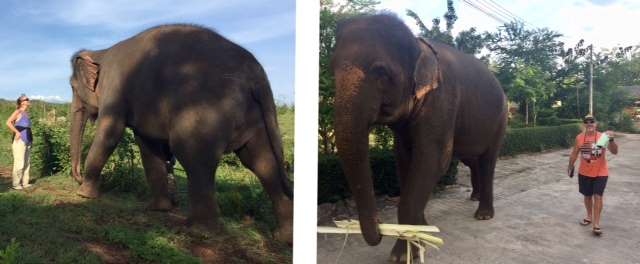
It was apparent to me that Thom’s loves and cares for Tutdao and Ot like family. Yes, they make a living with these animals – and consequently, the creatures are well taken care of. What’s more, the animals themselves truly seem to enjoy their interactions with humans. There were times when I could swear their mouths and eyes were smiling. And they love to get out of their pens and trek through the fields and to the river for swims and foraging – which is what the tourist customers make possible.
Do I wish Tutdao and Ot had the freedom that nature intended? Of course. But it isn’t realistic or possible. Further, it is truly hypocritical for foreigners to find fault with Thai animal practices when things like horse and dog racing, rodeos, bull fights, dressage, hunting, trapping, puppy mills, and factory farms flourish in western countries.
I really don’t want to get into comparing human cruelties. But who are we to criticize another culture’s animal customs when the pet store at any U.S. mall is selling exotic imported birds and fish? In fact, I’m not a zoologist, but in my estimation, elephants like Tutdao and Ot are in a much better situation than elephants in many zoos around the world.
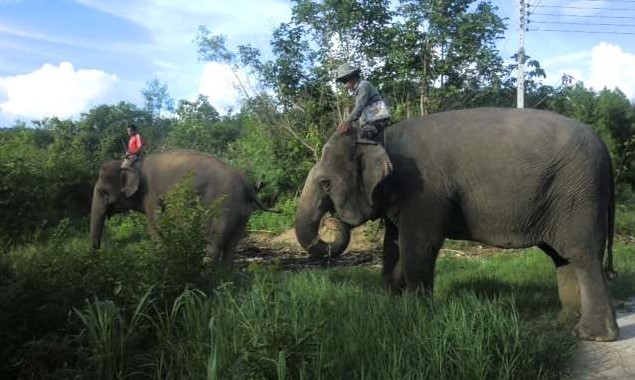
On the topic of elephant riding: I did not ride Tutdao or Ot, although I was tempted. And I understand and respect the opinion of those who object to the practice. They should not ride elephants. Still, I was especially struck by the spectacle of a single mahout (elephant trainer/tender) riding bareback atop his charge. It was a scene of beauty and peace, no different than between a beloved horse and its owner.
For the record, even anti-elephant riding groups, generally concede that elephants can easily carry 500 pounds on their backs without harm – provided the weight is kept off their spine in a properly designed and padded ‘chair’ (houdah). The main objection now seems to be that continued riding for profit encourages the training of future generations of elephants for riding and profit.
Indeed, we saw numerous people on the backs of elephants from camps other than Thom’s, during our visits. Sometimes a family of three or four were squeezed into a houdah atop the animal as it lumbered along, led by a mahout. Honestly, it didn’t look especially comfortable for any of those involved. Thankfully, all the rides we witnessed were short – maybe 15-20 minutes. And any single elephant didn’t seem to give more than a few rides per day — so whatever stress the animal might have felt was hopefully minimal. Further, the elephant always received food and water and treats before and after the excursions which they seemed happy about.
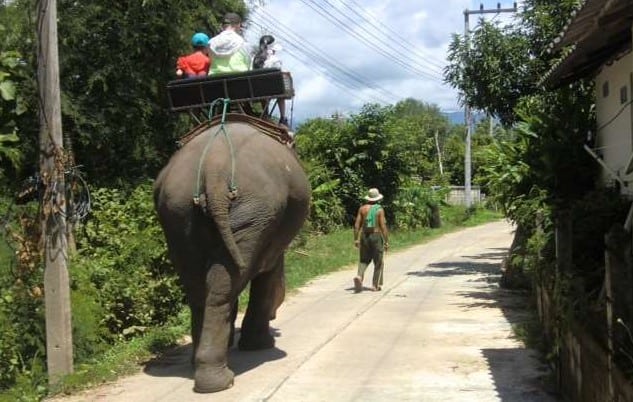
In all, while I can’t condone the commercial riding that we witnessed, it didn’t appear overly cruel or inhumane. ‘Awkward’ might be the best descriptor — as if all involved, including the elephant, knew it was unfortunately necessary for the animal to remain fed and healthy. And of course, the owner of the animal received $60-$80-$100 per ride which kept a human family fed and healthy as well. Here again, it seems highly hypocritical for comparatively well-to-do westerners to find fault with Thai families of modest means who are simply surviving.
Finally, I also can’t help but remember back to my career in local TV news. When a story about a neglected animal would be broadcast, dozens of enraged viewers would call the news desk offering donations and demanding punishment to the perpetrator. Yet when a story about an abused CHILD (especially black or brown skinned) would air — there might be a call or two.
My point is, that while rural Thailand elephant welfare is an easy hot-button issue, it seems to me, things like HUMAN welfare, exploitation, poverty, displacement, warfare, pollution, deforestation, climate change, and reckless and regressive political policy which endangers humans, elephants and ALL life on this precious planet might be better places to focus demands for reform.
Our offer to temporarily help manage the elephant camp operations still stands. We would be open to returning to northern Thailand at any point in our travel future. And I would very much like to spend time with Tutdao and Ot again. Elephants can live 80 years, and they are only 25 and 35. I feel like we are friends and I’d like to think they would remember me. We could again share a hug, a snack, a river swim. I might even take a ride.
It makes me melancholy to imagine their current daily routine extending for decades more. But Thom’s also has a large farm (growing ‘elephant grass’ food) where they can ‘retire’ at some point. Hopefully, they can continue to enjoy, and provide joy to, the tourists who support them until then.

As always, give thanks for your blessings, happy trails & more beer.
Life is now!
Thanks for reading “Thailand elephant debate: Gentle giants and their care.”
You might also like:

